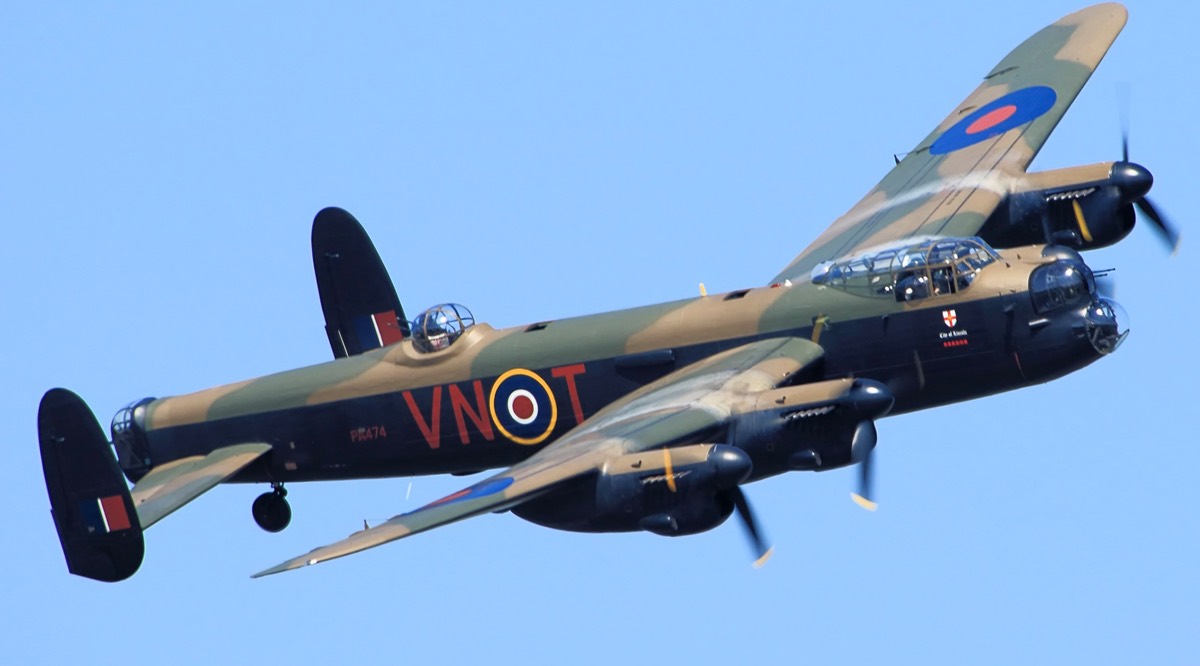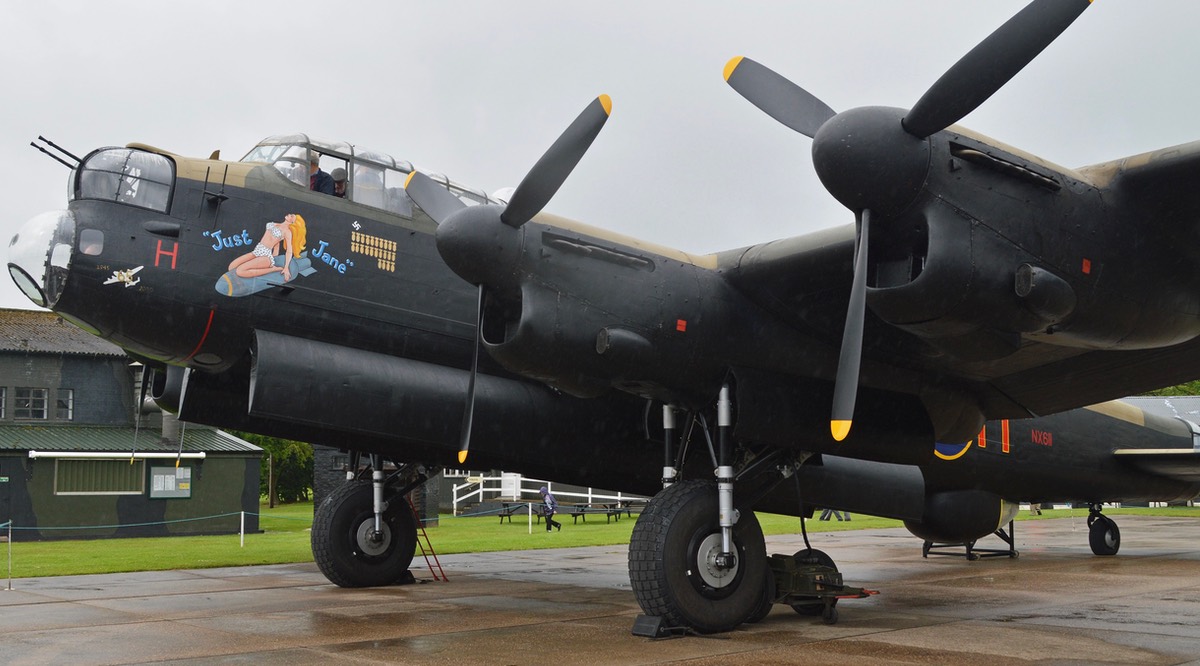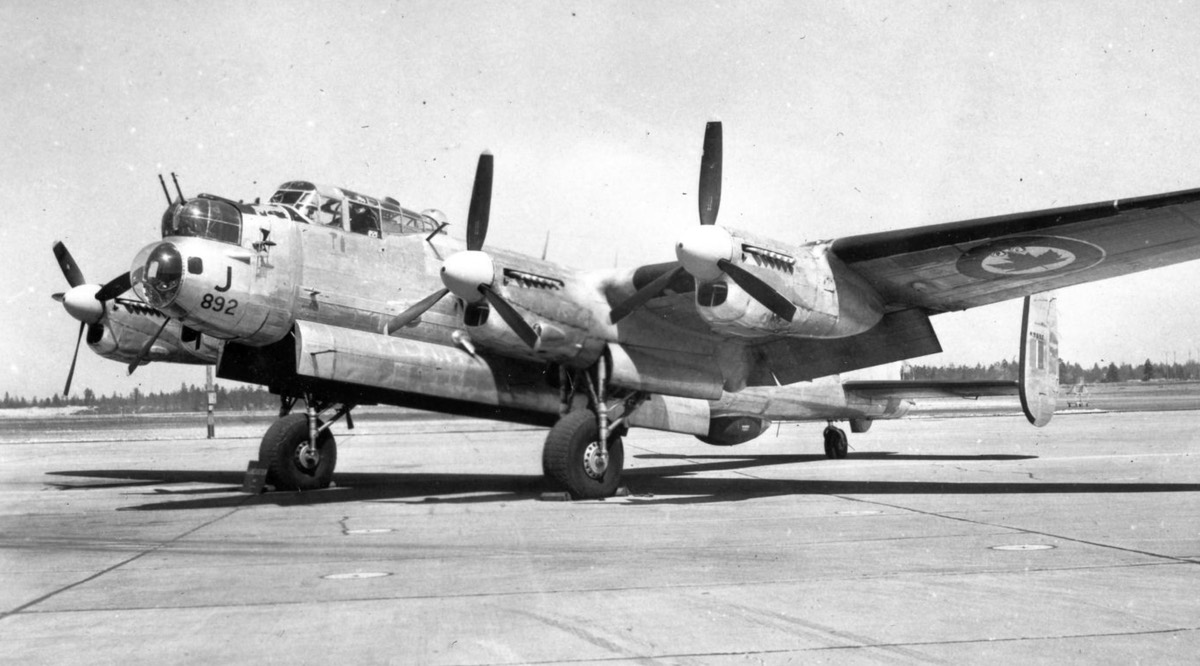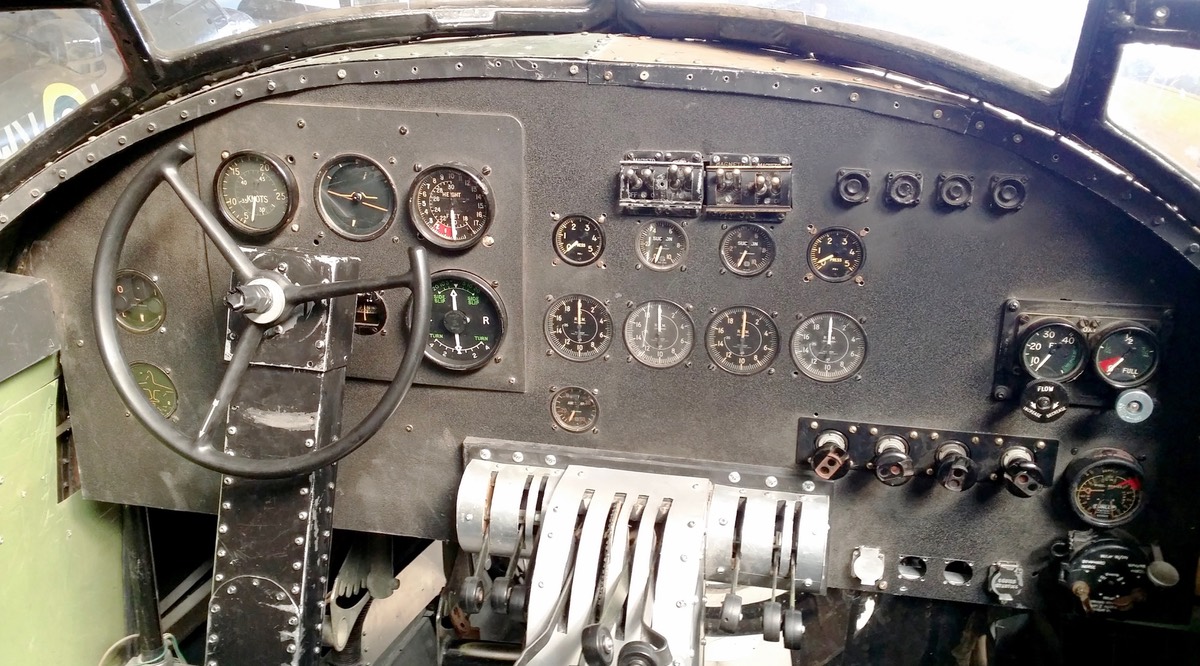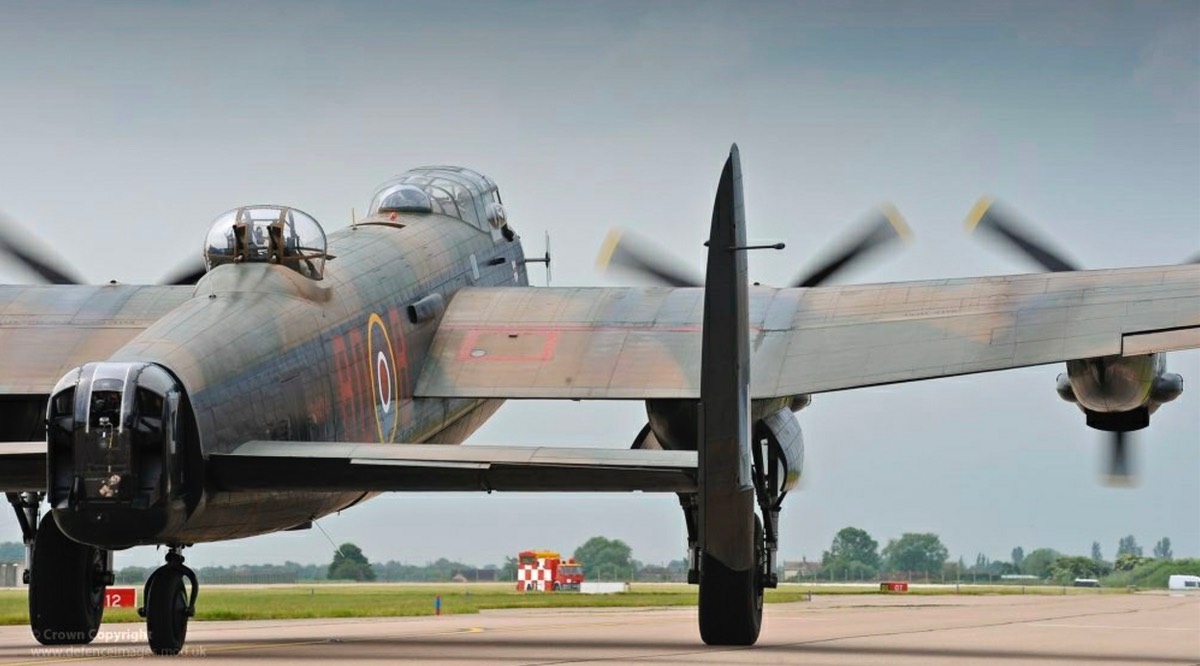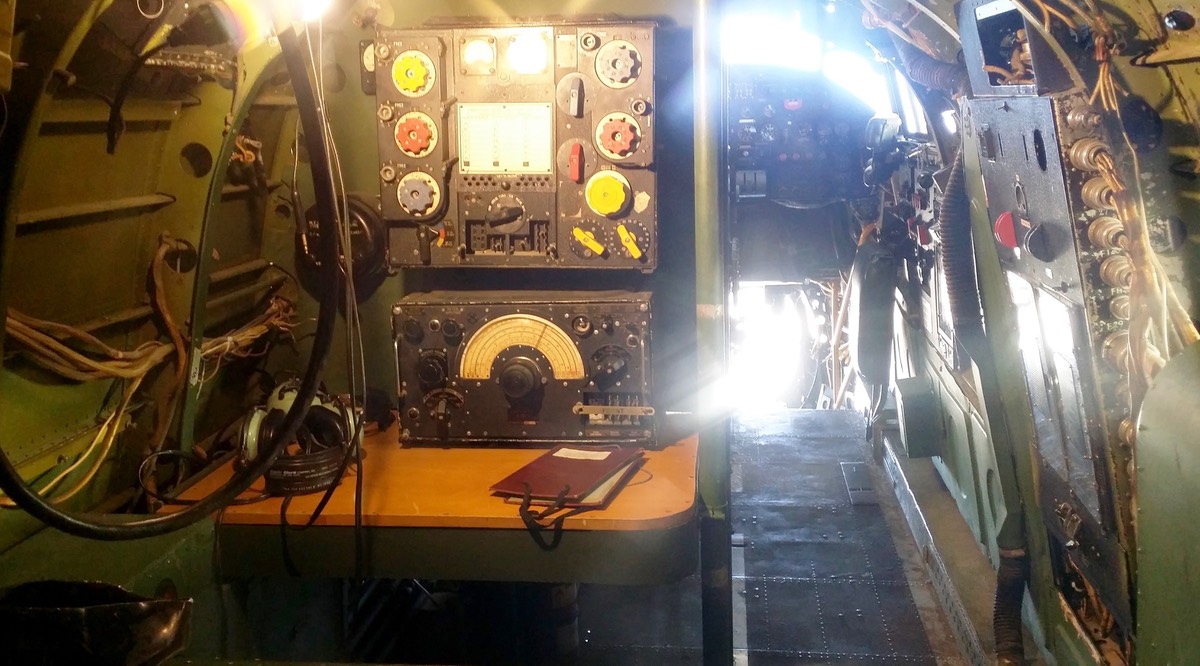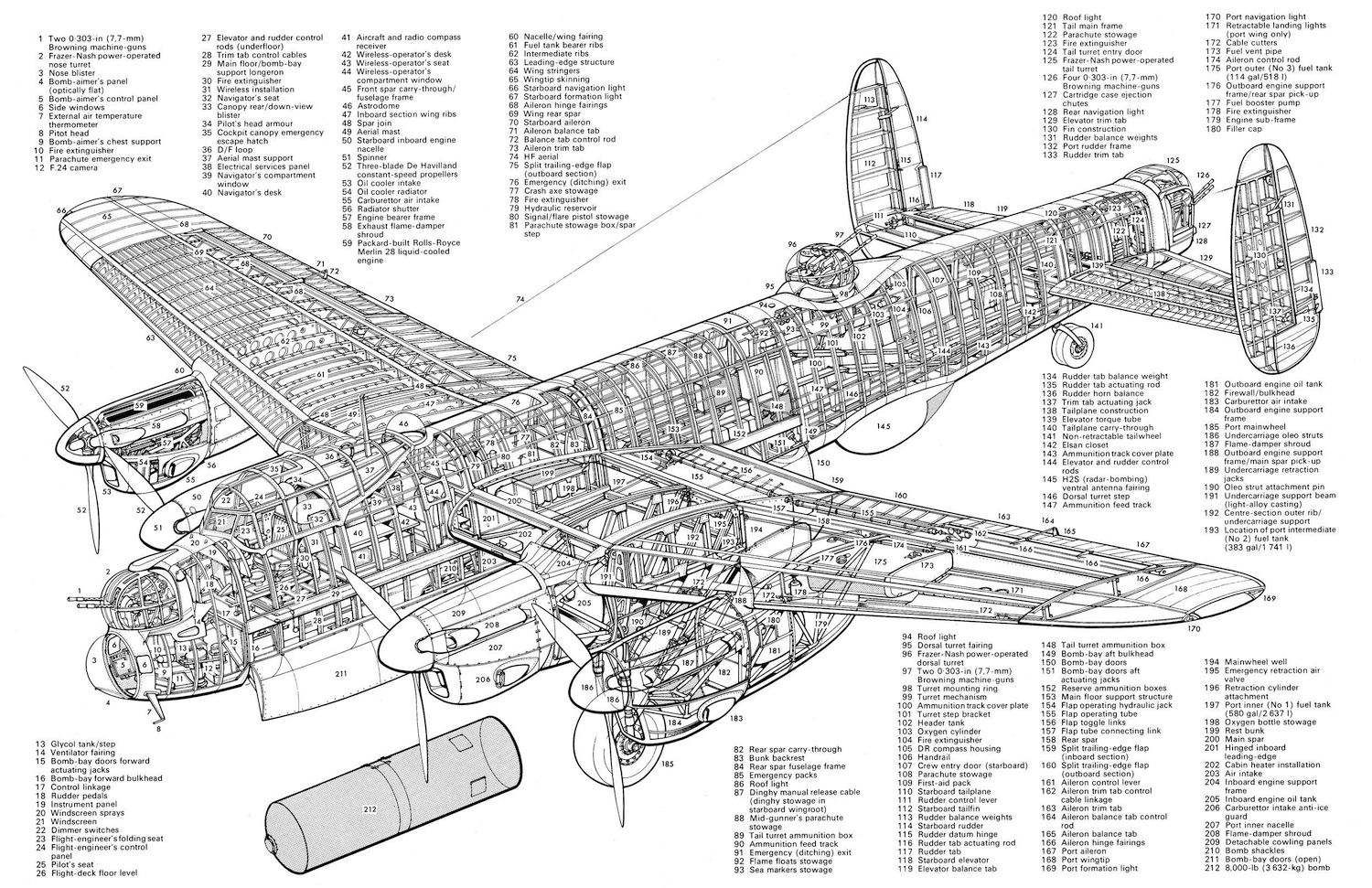Price: $19.95
- 5 magazines and 8 manuals
- PDF contains 2,024 pages
- Content is keyword searchable
- Print a personal copy
- Pay via PayPal or Credit Card
- International orders welcome!
- Download files upon payment
June 1977
- First Among Equals, RAF Bomber Command
- Bell Airacuda
- Douglas B-18
- Hughes D-2/F-11 Recon/Bomber
February 1980
- Eagle & The Turtle, Exploring Antarctica in A Staggerwing Beech
- Big Bluff Buff (Boeing B-52 Stratofortress)
- Bomber Command, Night Raid To Stuttgart
- Mighty Mites, Part I (1947 Goodyear Midgets)
June 1989
- V-22 Osprey Tilt-Rotor King
- Arado 234 Blitz Bomber
- RAF Bomber Command, Firestorm Raids
June 2002
- Lancaster: Best Bomber of WWII?
- Saga of the Bell X-2
- Vietnam Combat Artist’s Diary
January 1998
- Disaster over Nuremberg, WWII’s Bloodiest Bombing Mission
- Cam Ship, First & Last of the Convoy Suicide Fighters
- Roving Sands, the most realistic war game confrontation
Manuals & Photos
- Lancaster I Pilot’s Notes, 1942
- Lancaster II Pilot’s Notes, 1943
- Lancaster III Pilot’s Notes, 1943
- Lancaster Mk. I and III Manual, 1943
- Lancaster Operating Instructions, 1953
- Lancaster Parts List, 1958
- Lancaster Pilot & Flight Engineer Notes, 1944
- Lancaster Pilot & Flight Engineer Notes, 1944 Updated
- Over 340 Avro Lancaster photos
Avro Lancaster
Lancaster I Specs
Variants
On Display
Cutaway
Videos
General Characteristics
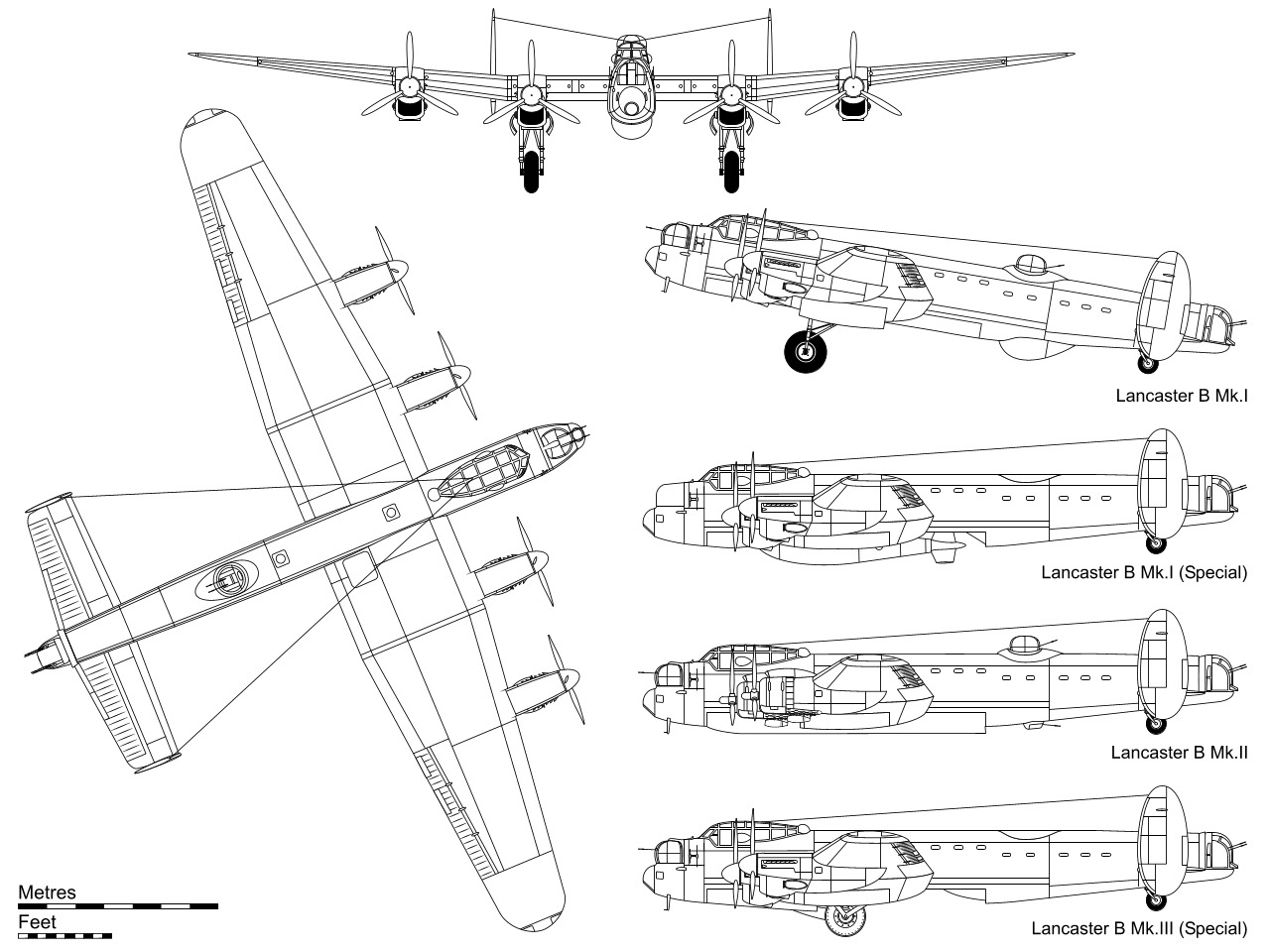
- Crew: 7: pilot, flight engineer, navigator, bomb aimer/nose gunner, wireless operator, mid-upper and rear gunners
- Length: 69 ft 4 in (21.13 m)
- Wingspan: 102 ft 0 in (31.09 m)
- Height: 20 ft 6 in (6.25 m)
- Wing area: 1,297 sq ft (120.5 m2)
- Airfoil: root: NACA 23018; tip: NACA 23012
- Empty weight: 36,900 lb (16,738 kg)
- Gross weight: 55,000 lb (24,948 kg)
- Max takeoff weight: 68,000 lb (30,844 kg)
- Powerplant: 4 × Rolls-Royce Merlin XX V-12 liquid-cooled piston engines, 1,280 hp (950 kW) each
- Propellers: 3-bladed
Performance
- Maximum speed: 282 mph (454 km/h, 245 kn) at 63,000 lb (28,576 kg) and 13,000 ft (3,962 m) altitude
- Cruise speed: 200 mph (320 km/h, 170 kn)
- Range: 2,530 mi (4,070 km, 2,200 nmi)
- Service ceiling: 21,400 ft (6,500 m) at 63,000 lb (29,000 kg)
- Rate of climb: 720 ft/min (3.7 m/s) at 63,000 lb (29,000 kg) and 9,200 ft (2,800 m) altitude
Armament
- Guns: Two 0.303-inch (7.7 mm) Browning Mark II machine guns in nose turret, two 0.303-inch Browning Mark II machine guns in upper turret, and four 0.303-inch Browning Mark II machine guns in the rear turret. (Early aircraft had two Brownings in a ventral turret aimed from within the aircraft via a periscope.)
- Bombs: Maximum normal bomb load of 14,000 lb (6,400 kg) of bombs
Avionics
- H2S radar in later variants
- T1154 and R1155 radios
- Gee
- Monica
- various other nav-aids and countermeasures
- B.I
- The original Lancasters were produced with Rolls-Royce Merlin XX engines and SU carburettors. Minor details were changed throughout the production series – for example, the pitot head design was changed from being on a long mast at the front of the nose to a short fairing mounted on the side of the fuselage under the cockpit. Later production Lancasters had Merlin 22 and 24 engines. No designation change was made to denote these alterations.
- B.I Special
- 32 Aircraft were adapted to take first the super-heavy “Tallboy” and then “Grand Slam” bombs. Up-rated engines with paddle-bladed propellers gave more power, and the removal of gun turrets reduced weight and gave smoother lines. For the Tallboy, the bomb bay doors were bulged; for the Grand Slam, they were removed completely and the area faired over. For some Tallboy raids, the mid-upper turret was removed. This modification was retained for the Grand Slam aircraft, and in addition, the nose turret was later removed. Two airframes (HK541 and SW244) were modified to carry a dorsal “saddle tank” with 1,200 imp gal (5,500 l; 1,400 US gal) mounted aft of a modified canopy for increasing range. No. 1577 SD Flight tested the aircraft in India and Australia in 1945 for possible use in the Pacific, but the tank adversely affected handling characteristics when full and an early type of in-flight refuelling designed in the late 1930s for commercial flying boats was later used instead.
- PR.1
- B 1 modified for photographic reconnaissance, operated by RAF No. 82 and No. 541 Squadrons, wartime. All armament and turrets were removed with a reconfigured nose and a camera carried in the bomb bay. The type was also operated by 683(PR) Squadron when it was re-formed in November 1950 to undertake photographic reconnaissance and mapping activities, initially based at RAF Fayid, Egypt, before moving to RAF Kabrit in February 1951, and subsequently Habbaniya in Iraq until the squadron was disbanded on 30 November 1953.
- B.I (FE)
- In anticipation of the needs of the Tiger Force operations against the Japanese in the Far East (FE), a tropicalised variant was based on late production aircraft. The B.I (FE) had modified radio, radar, nav-aids, and a 400 imp gal (1,800 l; 480 US gal) tank installed in the bomb bay. Most were painted with white upper surfaces to reduce internal temperatures in the tropical sun, and black undersides with a low demarcation between the colours, completely omitting any red colours on the national insignia in all cases to avoid confusion with the hinomaru insignia of the Japanese.
- B.II
- Bristol Hercules (Hercules VI or XVI engines) powered variant, of which 300 were produced by Armstrong Whitworth. One difference between the two engine versions was that the VI had manual mixture control, requiring an extra lever on the throttle pedestal. Very early examples were fitted with an FN.64 ventral turret; however, these were quickly removed due to problems with aiming the turret through its periscope (which prevented the gunner from seeing a target he was not already aiming at), and inadequate traverse speed.
- Due to the Luftwaffe Schräge Musik attacks, a variety of unofficial field modifications were made, including the fitting of 20 mm (0.79 in) cannon or a .50 in (13 mm) machine gun in the open hole where the FN.64 had been installed, before an official modification (Mod 925) fitted with a .303 in (7.7 mm) machine gun was authorised for the same location, though not used in all aircraft. These were rarely installed on other variants as the H2S radar was usually installed, however the B.II’s bulged bomb bay interfered with its installation, leaving the opening free. Three types of bulged bomb bay were used on the B.II, the prototype having a narrow bulge running from just aft of the cockpit to the turret location, while early production examples had a full-width bulge that ran the same length and on late production examples, the bomb bay doors prominently bulged throughout their length.
- B.III
- This variant, which was built concurrently with the B.I and was indistinguishable externally from that variant, was fitted with Packard-built Merlin engines. The Packard Merlins used Bendix – Stromberg pressure-injection carburettors, requiring the addition of slow-running cut-off switches in the cockpit.
- B.III (Special)
- Known at the time of modification as the “Type 464 Provisioning” Lancaster, 23 aircraft of this type were built to carry the “Upkeep” bouncing bomb for the dam busting raids. The bomb bay doors were removed and Vickers-built struts to carry the bomb were fitted in their place at Woodford Aerodrome near Stockport where the workers worked day and night. A hydraulic motor, driven by the pump previously used for the mid-upper turret was fitted to spin the bomb. Lamps were fitted in the bomb bay and nose for the simple height measurement system which enabled the accurate control of low-flying altitude at night. The mid-upper turret was removed to save weight and the gunner moved to the front turret to relieve the bomb aimer from having to man the front guns so that he could assist with map reading.
- ASR.III/ASR.3
- B.III modified for air-sea rescue, with three dipole ventral antennas fitted aft of the radome and carrying an airborne lifeboatin an adapted bomb bay. The armament was often removed and the mid-upper turret faired-over, especially in postwar use. Observation windows were added to both sides of the rear fuselage, a port window just forward of the tailplane and a starboard window into the rear access door. A number of ASR 3 conversions were fitted with Lincoln-style rudders.
- GR.3/MR.3
- B.III modified for maritime reconnaissance.
- B.IV
- The B.IV featured an increased wingspan and lengthened fuselage and new Boulton Paul F turret (two X 0.5in Browning machine guns) with framed “bay window” nose glazing. The prototypes (PW925, PW929 and PW932) were powered by two-stage Merlin 85s inboard and later, Merlin 68s on the outboard mounts. Because of the major redesign, the aircraft was quickly renamed Lincoln B 1.
- B.V
- Increased wingspan and lengthened fuselage, two-stage Merlin 85s. Renamed Lincoln B 2.
- B.VI
- Nine aircraft converted from B.IIIs. Fitted with Merlin 85/87 which had two-stage superchargers, giving much improved high-altitude performance. The B VI could achieve a maximum speed of 313 mph (504 km/h) at 18,200 ft (5,500 m) at a 65,000 lb (29,000 kg) takeoff weight and a service ceiling of 28,500 ft (8,700 m) at the same weight. Climb to 28,000 ft (8,500 m) at 65,000 lb (29,000 kg) takeoff weight was accomplished in 44.8 minutes with a maximum climb rate of 1,080 ft/min (5.5 m/s) at 1,000 ft (300 m). A Lancaster B VI was dived to a maximum indicated speed of 350 mph (560 km/h), or Mach 0.72 at 25,000 ft (7,600 m) in June 1944. The Merlin 85/87 series engines were fitted with annular cowlings similar to the Avro Lincoln and three-bladed paddle-type propellers were fitted. These aircraft were used by only Pathfinder units; by No. 7 Squadron RAF, No. 83 Squadron RAF, No. 405 Squadron RCAF and by No. 635 Squadron RAF. Often used as a “Master Bomber” the B VIs were allocated to RAF Bomber Command apart from two that were retained by Rolls-Royce for installation and flight testing. Their dorsal and nose turrets were removed and faired over. The more powerful engines proved troublesome in service and were disliked by ground maintenance staff for their rough running and propensity to ‘surge and hunt’, making synchronisation impossible. This was caused by variations in the fuel/air mixture and over time would damage the engine. The B VI was withdrawn from operational service in November 1944 and surviving aircraft were used by Rolls-Royce, the Royal Aircraft Establishmentand the Bomb Ballistics Unit (BBU) for various testing and experimental duties.
- B.VII
- The B.VII was the final production version of the Lancaster. The Martin 250CE mid-upper turret was moved slightly further forward than on previous Marks and the Nash & Thomson FN-82 tail turret with twin 0.50 in (12.7 mm) Browning machine guns replaced the FN.20 turret with four Browning .303 Mark IIs. The Martin turret carried two 0.5-inch Browning Mark II machine guns which packed much more punch than the .303s of the older turret. However, these Martin turrets arrived too late for inclusion in the first 50 aircraft built by Austin and these were therefore referred to as Mark VII (Interim). Another 180 true Mark VIIs were built at Longbridge. Two sub-variants of the VII existed, the “Far East” (B VII FE) for use in tropical climates and the B VII “Western Union”, which went to France.
- B.X
- The B.X was a Canadian-built B.III with Canadian- and US-made instruments and electrics. In later batches, the heavier Martin 250CE was substituted for the Nash & Thomson FN-50 mid-upper turret, mounted further forward to maintain centre of gravity balance. Canada was a long-term operator of the Lancaster, using modified aircraft after the war for maritime patrol, search and rescue and photo-reconnaissance until 1964. The last flight by the RCAF was by F/L Lynn Garrison in KB-976, on 4 July 1964 at the Calgary International Air Show.
- During the Second World War, Canada’s Victory Aircraft (what later became Avro Canada) was responsible for the development of the Lancastrian, which was duly designated the XPP for Mark 10 Passenger Plane. Six were built for Trans Canada Airlines.
- Postwar the RCAF modified the B X (as the Lancaster Mk 10) to fill a variety of roles, with specific designations for each role. These included:
- 10AR: Area Reconnaissance – three aircraft modified for surveillance operations over the Arctic. Fitted with the lengthened nose (40 inches (100 cm) longer) and carrying cameras and ELINT equipment. Remained in service until 1964.
- 10BR: Bomber Reconnaissance. Minimally modified variant with additional windows for observers in the rear fuselage. 13 converted.
- 10DC: Drone controller with Ryan Firebee drones – two modified in 1957 and operational until 1961.
- 10MR (later 10MP): Maritime Reconnaissance or Maritime Patrol anti-submarine warfare (ASW) aircraft, based on BR with the mid-upper turret removed. 70–75 converted. In service from 1950 to 1955.
- 10N: Navigational trainer. Five converted.
- 10O: Orenda jet engine testbed for the engine used in the Avro CF-100.
- 10P: Photo reconnaissance mapping duties. 11 converted 1948–1950. Retired 1964.
- 10S&R: Interim search-and-rescue aircraft, minimally modified 10S. Replaced by disarmed 10BR and 10MRs.
- 10S : Standard – designation applied to baseline standard, with Merlin 224 engines, Martin mid-upper turret and H2S radar, for aircraft retained postwar for future use. Sometimes referred to by unofficial designation 10U.
- B.XV
- As per Lancaster B.IV/Lincoln B.1 but built in Canada and renamed Avro Lincoln XV. One example was built before the order was cancelled when the war ended.
Surviving Aircraft by Manufacturer
| Manufacturer | Number Produced | Number Surviving |
|---|---|---|
| Avro | 3,673 | 0 |
| Armstrong Whitworth Aircraft | 1,329 | 0 |
| Austin Motor Company | 330 | 4 |
| Metropolitan-Vickers | 1,080 | 2 |
| Vickers-Armstrongs | 535 | 1 |
| Victory Aircraft (Canada) | 430 | 10 |
| Total | 7,377 | 17 |
Surviving Aircraft
| Serial | Location | History |
|---|---|---|
| R5868
Static display |
Royal Air Force Museum, London | Built by Metropolitan-Vickers in Manchester as Mk. I. Delivered to 83 Squadron, RAF Scampton, 29 June 1942 as OL-Q “Queen.” Transferred to the Australian 467 Squadron September 1943 as PO-S “Sugar.” Completed 137 combat sorties and then participated in food supply and POW repatriation (Operation Exodus). Marked as “non-effective” but kept in storage as being of particular note due to the number of missions completed. Struck off 16 March 1956 and transferred to Air Historical Branch. Sent to RAF Fulbeck in 1958 for storage. In April 1959 moved to RAF Scampton for display. Painted in 83 Squadron markings in 1960. Remained Gate Guardian at Scampton until allotted to RAF Museum in August 1970. Following restoration moved to Hendon in March 1972 and repainted with 467 markings. Moved to new Bomber Command Museum hall at Hendon in August 1982. |
| W4783
Static display |
Australian War Memorial, Canberra | Built by Metropolitan-Vickers in Manchester as Mk. I. Assigned to 460 Squadron 22 October 1942 as AR-G “G for George”. Flew first sortie 6 December 1942, and eighty-ninth and final sortie 20 April 1944. Flown to Australia 11 October 1944 and arrived 8 November in Brisbane. Flown in Eastern Australia in 1945 as part of Third Victory Loan Drive. Left at RAAF Base Fairbairn until 1955. Moved to AWM in 1950s. Repainted in 1978. Removed from display in 1999 and given full restoration at AWM’s Treloar Technology Centre. Put back on display in ANZAC Hall in December 2003. |
| FM104
Under restoration for display |
British Columbia Aviation Museum, Sidney, British Columbia | Built at Victory Aircraft in Malton, Ontario as Mk. X. Flown to England in January 1945. Kept in reserve at No. 32 Maintenance Unit for 408 Squadron RCAF and 428 Squadron. Returned to Canada 10 June 1945 in expectation of use with Tiger Force against Japanese. Converted in November 1945 to Mk.10SR and assigned to No. 10 RU at Naval Station Argentia. Converted to Mk.10MR in April 1951 and assigned to 107 Unit at RCAF Torbay. Struck off 10 February 1964. Displayed at Canadian National Exhibition in 1964. Purchased by RCAF Association and put on display in Coronation Park in 1965. Ownership transferred to Heritage Toronto in 1990. Moved to Toronto Aerospace Museum (later the Canadian Air and Space Museum) in 1999. Following the museum’s closure in 2011, the plane went into storage. In June 2018 obtained by the British Columbia Aviation Museum. Will be restored to static display in post-war Maritime Command configuration. Restoration to be carried out by the museum in conjunction with Victoria Air Maintenance Ltd. |
| FM136
Static display |
The Hangar Flight Museum, Calgary, Alberta | Built at Victory Aircraft in Malton, Ontario as Mk. X. Flown to England June 1945 but returned to Canada 29 August 1945. Served as RCAF Maritime Reconnaissance plane with 404 Squadronat RCAF Greenwood and 407 Squadron at RCAF Comox. Flown to RCAF Fort Macleod in 1961 for scrap. Purchased in 1961 by Lynn Garrison and put on display in 1962 at entrance of Calgary Municipal Airport as a memorial to those who trained under the British Commonwealth Air Training Plan. Transferred to Calgary Aerospace Museum in 1992. Wears livery of KB895, which flown by Calgary’s Ronnie Jenkins. |
| FM159
Static display, working engines, taxiable condition |
Bomber Command Museum of Canada, Nanton, Alberta | Built at Victory Aircraft in Malton, Ontario as Mk. X. Flown to England in May 1945 and returned to Canada in September 1945. Served as RCAF Maritime Reconnaissance plane from 1953 to 1958 with 103 Squadron at RCAF Greenwood and 407 Squadron at RCAF Comox. Flown to RCAF Vulcan in 1960 for scrapping. Purchased that year and moved to Nanton, Alberta for display. Has undergone gradual restoration since the formation of the Nanton Lancaster Society in 1986. All four engines now run and the aircraft is taxiable. Most crew station equipment has been restored. Flaps, rear turret and bomb bay doors are operational. Wears livery of ND811 in honour of Ian Bazalgette VC. |
| FM212
Under restoration for display |
Canadian Historical Aircraft Association, Windsor, Ontario | Built at Victory Aircraft in Malton, Ontario as Mk. X. Returned to factory, by then owned by Avro Canada, in 1948 and converted to Mk.10P. Served with 9 Squadron, 418 Squadron, and 408 Squadron. Struck off 9 October 1964. Stored at RCAF Dunnville. Sold to City of Windsor, Ontario and moved on barge. Placed on display on plinth in Jackson Park. Currently undergoing restoration by Canadian Historical Aircraft Association. |
| FM213
Airworthy |
Canadian Warplane Heritage Museum, Hamilton, Ontario | Built at Victory Aircraft in Malton, Ontario as Mk. X. Stored in Trenton, Ontario from 1945 to 1950. Converted to Mk.10MR by de Havilland Canada. Served with 405 Squadron at RCAF Greenwood and 107 Rescue Unit at RCAF Torbay. Struck off 30 June 1964. Stored at RCAF Dunnville. Purchased by and displayed at Royal Canadian Legion in Goderich, Ontario. Purchased by Canadian Warplane Museum and moved to Hamilton in November 1979. After restoration, flown for first time on 11 September 1988. Wears livery of KB726 of 419 Squadronin honour of Andrew Mynarski VC. Along with PA474 one of only two airworthy Lancasters. |
| KB839
Static display |
Greenwood Military Aviation Museum, Greenwood, Nova Scotia | Built at Victory Aircraft in Malton, Ontario as Mk. X. Flown to England 1 January 1945. Assigned to 431 Squadron as SE-G, and then to 419 Squadron as VR-D “D Daisy.” Flew 26 sorties. Returned to Canada 5 June 1945. Sent to Avro Canada and converted to Mk.XAR. Served with 405 Squadron and 408 Squadron until 1961. Stored at RCAF Dunnville. Flown to Greenwood, Nova Scotia in 1964 and mounted on pedestal. Later transferred to Military Aviation Museum. Wears livery of JB226 of 405 Squadron, which was lost 18 November 1943. |
| KB882
Under restoration for display |
National Air Force Museum of Canada, Trenton, Ontario | Built at Victory Aircraft in Malton, Ontario as Mk. X. Flown to England in 24 February 1945. Assigned to 431 Squadron without code, and then to 428 Squadron as NA-R “Rabbit Stew.” Flew 19 sorties. Returned to Canada 2 June 1945. Stored in Alberta. Sent to Avro Canada in 1952 and converted to Mk.10P. Served with 408 Squadron at RCAF Rockcliffe. Struck off 26 May 1964. Purchased in 1964 by City of Edmundston, New Brunswick. Ownership transferred to National Air Force Museum in Trenton, Ontario. Was moved in September 2017. Restoration work began immediately and will be completed by 1 April 2024, the 100th anniversary of the RCAF. Will be restored as post-War Mk.10AR. |
| KB889
Static display |
Imperial War Museum, Duxford, Cambridgeshire | Built at Victory Aircraft in Malton, Ontario as Mk. X. Flown to England 3 January 1945. Assigned to 428 Squadron as NA-I. Did not fly any sorties and returned to Canada 4 June 1945. Converted to Mk.10P by Avro Canada. Served with 408 Squadron at RCAF Torbay. Struck off 21 May 1965. Sold to Age of Flight in Niagara Falls, Ontario in May 1964 and put on display at Niagara Falls Museum in 1965. Sold to Ken Short in 1968. Was transported to the airport at Oshawa, Ontario and reassembled in 1969-70. Purchased by Douglas Arnold and sent to England in 1984. Restored using parts from Avro Lincoln RF342. Sold to Imperial War Museum in 1986. Went on display in November 1994. Wears original livery. |
| KB944
Static display |
Canada Aviation and Space Museum, Ottawa, Ontario | Built at Victory Aircraft in Malton, Ontario as Mk. X. Flown to England 8 March 1945 as Mk. X. Assigned to 425 Squadron as KW-K. Did not fly any sorties and returned to Canada 15 June 1945. Stored at BCATP Fort Macleod. Converted to Mk.10S by Fairey Aviation, Eastern Passage, Nova Scotia. Served with 404 Squadron at RCAF Greenwood. Struck off January 1957. Stored at RCAF Dunnville. Restored by RCAF. Purchased by National Aviation Museum in May 1964. Wears livery of KB760 of 428 Squadron. |
| KB976
Dismantled and in storage |
Fantasy of Flight, Polk City, Florida | Built by Victory Aircraft in Malton, Ontario as Mk. X. Flown to England 24 May 1945. Assigned to 405 Squadron as LQ-K. Did not fly any sorties. Returned to Canada 17 June 1945. Converted to Mk.10AR. Served with 408 Squadron. Struck off 26 May 1964. Purchased in April 1964 by Lynn Garrison of Calgary, Alberta. Sold in 1969 to Northwestern Air Lease Ltd (Terry Harrold) and used as water bomber in St. Albert, Alberta. Purchased in September 1974 by Sir William J.D. Roberts and flown to Scotland in June 1975. Damaged in hangar collapse, August 1987. Sold in 1993 to Kermit Weeks and placed in storage at Fantasy of Flight, Polk City, Florida. Includes sections from KB994. |
| NX611
Taxiable condition; under restoration to airworthiness |
Lincolnshire Aviation Heritage Centre, East Kirkby, Lincolnshire | Built by Austin Motors in Birmingham as Mk. VII. Stored at RAF Llandow after War. One of 22 Lancasters sold in April 1952 to French Aéronautique navale. Sent to Nouméa, New Caledonia in 1962. Given by French to Historical Aircraft Preservation Society in 1964. After overhaul in Sydney, arrived at Biggin Hill 13 May 1965. Moved to Lavenham in Suffolk and sold to Rt Hon Lord Lilford in 1972. It was the gate guardian of RAF Scampton replacing R5868. Purchased by Fred and Harold Panton in September 1983. Restoration underway to airworthy status. |
| NX622
Static display |
Aviation Heritage Museum, Bull Creek, Western Australia | Built by Austin Motors in Birmingham as Mk. VII. One of 22 Lancasters sold in April 1952 to French Aéronautique navale. Used until 1962. Donated to RAAF Association in 1962. Wears livery of LL847, which was shot down 18 December 1944. |
| NX664
Under restoration for display |
Musée de l’air et de l’espace, Paris | Built by Austin Motors in Birmingham as Mk. VII. Stored at Llandow after the war. One of 22 Lancasters sold in April 1952 to Aéronautique navale. Crash landed at Mata Utu, Wallis and Futuna in 1963. Recovered by Ailes Anciennes in 1984. Currently undergoing full restoration. Will wear French livery. |
| NX665
Static display |
Museum of Transport and Technology, Auckland, New Zealand | Built by Austin Motors in Birmingham as Mk. VII. One of 22 Lancasters sold in April 1952 to Aéronautique navale. Used until 1964. Placed on display in Auckland in 1964. Acquired in 1978 by MOTAT. Moved indoors in 1980s. |
| PA474
Airworthy |
RAF Coningsby, Coningsby, Lincolnshire | Built at Vickers-Armstrongs’s Broughton shadow factory as Mk. I. Placed in storage after War. Assigned to 82 Squadron in 1948 as photo reconnaissance plane in Africa. Loaned to Flight Refuelling Ltd. in August 1952, and College of Aeronautics at Cranfield in late 1952. Passed to Air Historical Branch in 1964. Restored at RAF Waddington and transferred to Battle of Britain Memorial Flight in 1973. New spar in 1995. Along with FM213, one of only two airworthy Lancasters in the world. |



